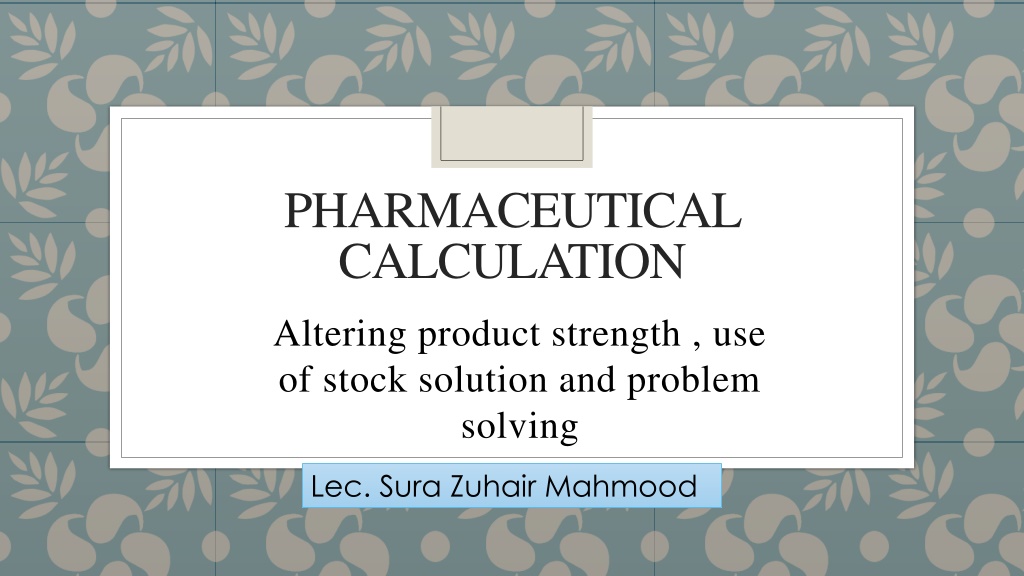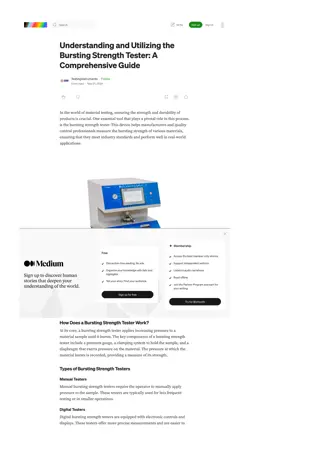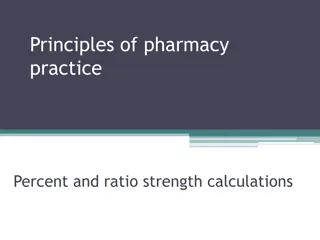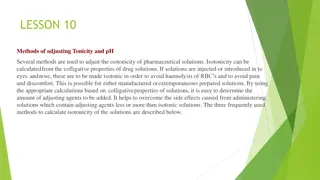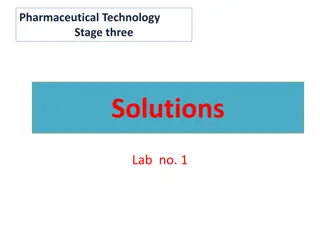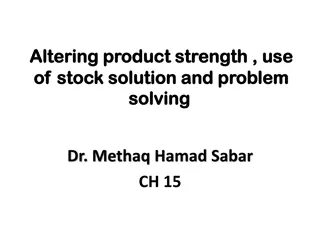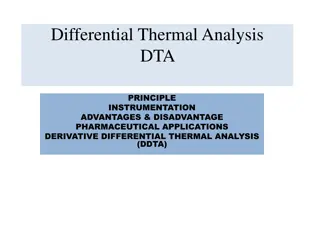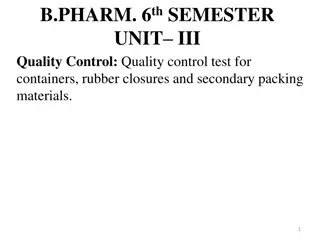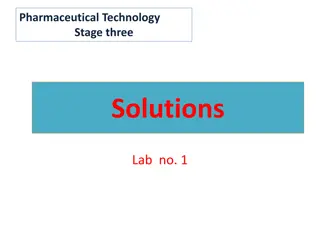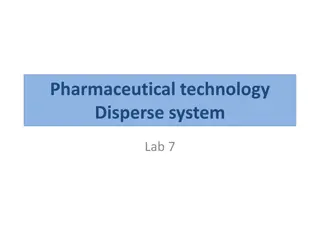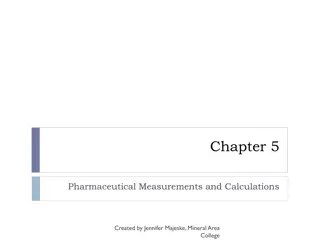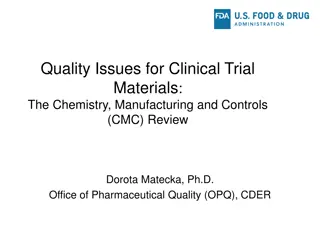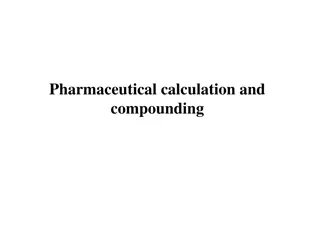Understanding Pharmaceutical Calculations: Altering Product Strength and Solutions
Pharmaceutical calculations involve altering the strength of pharmaceutical preparations by adjusting the proportion of active ingredients, using stock solutions, and problem-solving techniques. This process includes dilution, fortification, and concentration changes to achieve desired product strengths. Special considerations in compounding include selecting the right diluent for different dosage forms. Understanding the relationship between strength and total quantity is crucial in pharmaceutical compounding. Various rules and techniques are applied to simplify calculations and ensure accurate outcomes.
Download Presentation

Please find below an Image/Link to download the presentation.
The content on the website is provided AS IS for your information and personal use only. It may not be sold, licensed, or shared on other websites without obtaining consent from the author. Download presentation by click this link. If you encounter any issues during the download, it is possible that the publisher has removed the file from their server.
E N D
Presentation Transcript
PHARMACEUTICAL CALCULATION Altering product strength , use of stock solution and problem solving Lec. Sura Zuhair Mahmood
Text Book Howard C. Ansel, Pharmaceutical calculation 15th edition2017 Wolters Kluwer Lippincott Williams & Wilkins
Chp. 15 Altering Product Strength, Use of Stock Solutions, and Problem Solving by Alligation The strength of a pharmaceutical preparation may be increased or decreased by changing the proportion of active ingredient to the whole. A preparation may be strengthened or made more concentrated by the addition of active ingredient, by admixture with a like preparation of greater strength, or through the evaporation of its vehicle, if liquid. The strength of a preparation may be decreased or diluted by the addition of diluent or by admixture with a like preparation of lesser strength.
Special Considerations of Altering Product Strength in Pharmaceutical Compounding In the course of pharmacy practice, there are occasions in which the alteration of the strength of a pharmaceutical preparation is either desirable or required. The dilution of aliquid dosage form, as asolution or suspension, may be desired to provide a product strength more suitable for use by a particular patient (e.g., pediatric, elderly, those in disease states). The diluent is selected based on its compatibility with the vehicle of the original product; that is, aqueous, alcoholic, hydro alcoholic, or other. The dilution of a solid dosage form (as a powder or the contents of a capsule) or a semisolid dosage form(as an ointment or cream) also may be performed to alter the dose or strength of a product. Again, the diluent is selected based on its compatibility with the original formulation.
The concentration of a liquid preparation, as through the evaporation of a portion of its solvent or vehicle, rarely is performed now a days. However, the fortification of a liquid, solid, or semi solid dosage form, by the addition of a calculated quantity of additional therapeutic agent, remains aviable practice in pharmacy compounding. Note: To simplify the calculation ,these rules may be applied: 1. When the ratio strengths are given , convert them to percentage strengths before setting up proportion. For example 1/10 =10% 2. Whenever proportional parts enter into a calculation , reduce them to lowest term. For example 75 parts :25 parts = 3 parts: 1 part.
Relationship between strength and total quantity A. if a mixture of a given percentage or ratio strength is diluted to twice its original quantity, its active ingredient will be contained in twice as many parts of the whole, and its strength therefore will be reduced by one half. B. By contrast, if a mixture is concentrated by evaporation to one-half its original quantity, the active ingredient (assuming that none was lost by evaporation) will be contained in one half as many parts of the whole, and the strength will be doubled.
C. If, then, the amount of active ingredient remains constant, any change in the quantity of a solution or mixture of solids is inversely proportional to the percentage or ratio strength; that is, the percentage or ratio strength decreases as the quantity increases, and conversely. This relationship is generally true for all mixtures except solutions containing components that contract when mixed together. So, if 50mL of a solution containing 10g of active ingredient with a strength of 20% or 1:5w/v are diluted to100 mL, the original volume is doubled, but the original strength is now reduced by one half to10% or 1:10w/v. If, by evaporation of the solvent, the volume of the solution is reduced to 25mL or one half the original quantity, the10g of the active ingredient will indicate a strength of 40% or1:2.5w/v.
Problems in this section generally may be solved by any of the following methods: 1. Inverse proportion. 2. The equation: (1st quantity)x(1st concentration)=(2nd quantity)x(2nd concentration), or Q1x C1= Q2 x C2. 3. By determining the quantity of active ingredient (solute) present or required and relating that quantity to the known or desired quantity of the preparation.
Dilution and Concentration of Liquids Example Calculations of the Dilution and Concentration of Liquids If 500 mL of a 15% v/v solution are diluted to 1500 mL, what will be the percentage strength (v/v)?
How many milliliters of a 1:5000 w/v solution of the preservative lauralkonium chloride can be made from 125 mL of a 0.2% solution?
Exp/ If a syrupcontaining65%w/v of sucrose is evaporated to85%of its volume, what percentage (w/v) of sucrose will it contain? Any convenient amount of the syrup, for example,100mL, may be used in the calculation. If we evaporate100mL of the syrup to 85% of its volume, we will have 85mL. 85(mL)/100(mL) = 65(%)/ x(%) x = 76.47% or 76%, answer
If 1 gallon of a 30% w/v solution is to be evaporated so that the solution will have a strength of 50% w/v, what will be its volume in milliliters? 1 gallon = 3785 mL 50 (%) / 30 (%) = 3785 (mL) / x (mL) X = 2271 mL, answer.
If an injection containing a medication, 50 mg/10 mL, is diluted to 1L, calculate percent strength of the resulting solution?
Strengthening of pharmaceutical product Example: If a cough syrup contains in each teaspoonful, 1 mg of chlorpheniramine maleate and if a pharmacist desired to double the strength, how many milligrams of that ingredient would need to be added to a 60-mL container of the syrup. Assume no increase in volume. 1mg / 5mL 60mL= 12mg chlorpheniramine maleate in original syrup To double the strength, 12 mg of additional chlorpheniramine maleate would be required, answer.
Stock solutions are concentrated solutions of active (e.g., drug) or inactive (e.g., colorant) substances and are used by pharmacists as a convenience to prepare solutions of lesser concentration.
Alligation Alligation is an arithmetical method of solving problems that involves the mixing of solutions or mixtures of solids possessing different percentage strengths. Alligation medial is a method by which the weighted average percentage strength of a mixture of two or more substances of known quantity and concentration may be easily calculated.
